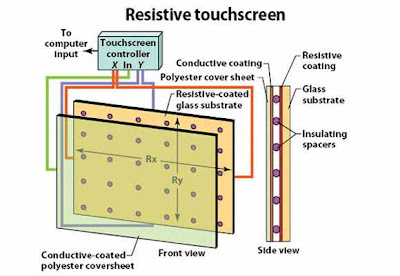Resistive Touchscreen Technology
Touchscreen technology is a common knowledge these days, and you can found devices with touchscreen technology almost everywhere. But, h...
https://findgadgetreview.blogspot.com/2012/04/resistive-touchscreen-technology.html
Touchscreen technology is a common knowledge these days, and you can found devices with touchscreen technology almost everywhere. But, have you ever wondered why some touchscreen devices are operated by tools like pen or stylus, while others are operated by hand, and they can’t be operated in any other way? If you’ve been using touchscreen devices like PDA in it's early days, having stylus is a must, and losing one is a disaster. Without the stylus, though you can operate the PDA by pressing your finger on it, but the PDA’s response is "ugly". On the other hand, if you use a newer touchscreen devices like iPhone or iPad, you will discover the opposite reaction from the device that it doesn’t react to either pen, stylus or other pointed tools. How come?
The reason is that, currently there are two different kinds of touchscreen available on the market; Resistive, and Capacitive, and they are working on different principles. In fact, there are more than two types of touchscreen technology (Surface acoustic wave, Surface capacitance, Projected capacitance, etc.), but I would like to focus on these two major types of technology, Resistive and Capacitive.
Resistive system screen coated by a metallic thin layer of conductive and resistive to electrical signals. Conductive layer is a layer that is easy to conduct electrical signals, while the resistive layer is a layer that holds the electrical current.
Both layers are separated by an air gap or microdots, so that the layers are separated from each other. Conductive layer is also running an electric current which serves as the reference current. When there is a touch on the screen, the two layers will bend and touch each other. Because of the contact between the conductive and resistive layers there will be interference with the reference electric current.
The interference effects on the conductive layer is going to change electrical currents in response to a touch. The change value on the reference current is then reported to the controller for further process. Touch information were processed mathematically by the controller to produce an accurate coordinates and position of the touch. Then creating a touch point.
Resistive display screen is not as clear as capacitive type. On some of the latest gadgets resistive systems have been modified with the kinetic scrolling, making it easier to sliding the page as in the iPhone capacitive system. The resistive touchscreens is capable to detect a pin sized touch point and great for tasks which requires precision.
The reason is that, currently there are two different kinds of touchscreen available on the market; Resistive, and Capacitive, and they are working on different principles. In fact, there are more than two types of touchscreen technology (Surface acoustic wave, Surface capacitance, Projected capacitance, etc.), but I would like to focus on these two major types of technology, Resistive and Capacitive.
Resistive system screen coated by a metallic thin layer of conductive and resistive to electrical signals. Conductive layer is a layer that is easy to conduct electrical signals, while the resistive layer is a layer that holds the electrical current.
Both layers are separated by an air gap or microdots, so that the layers are separated from each other. Conductive layer is also running an electric current which serves as the reference current. When there is a touch on the screen, the two layers will bend and touch each other. Because of the contact between the conductive and resistive layers there will be interference with the reference electric current.
The interference effects on the conductive layer is going to change electrical currents in response to a touch. The change value on the reference current is then reported to the controller for further process. Touch information were processed mathematically by the controller to produce an accurate coordinates and position of the touch. Then creating a touch point.
Resistive display screen is not as clear as capacitive type. On some of the latest gadgets resistive systems have been modified with the kinetic scrolling, making it easier to sliding the page as in the iPhone capacitive system. The resistive touchscreens is capable to detect a pin sized touch point and great for tasks which requires precision.

